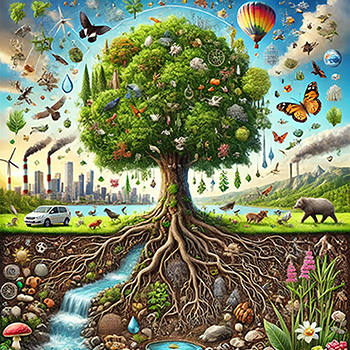Climate Regulation
Trees play a crucial role in regulating the climate. Through the process of photosynthesis, trees absorb carbon dioxide (CO₂) from the atmosphere and store it in their biomass, reducing the overall concentration of greenhouse gases. This helps mitigate climate change by balancing CO₂ levels and keeping global temperatures in check. Additionally, trees help to cool the air through a process called transpiration, where they release water vapor into the atmosphere, which cools the surrounding environment.
Biodiversity and Habitat
Forests and wooded areas are home to an incredible diversity of plant and animal species. Trees provide essential habitats for countless wildlife, including birds, insects, mammals, and fungi. By supporting these ecosystems, trees contribute to maintaining biodiversity, which is vital for ecosystem stability and resilience. Trees also offer food and shelter, playing a critical role in the life cycles of many species.
Water Cycle Regulation
Trees influence the water cycle in several important ways. Their root systems help to absorb and retain water, which reduces soil erosion and prevents runoff. This, in turn, helps to replenish groundwater supplies and maintain the health of nearby rivers and lakes. Additionally, by promoting the infiltration of rainwater into the soil, trees help to mitigate the risk of flooding and maintain the hydrological balance of an area.
Air Quality Improvement
Beyond producing oxygen, trees significantly improve air quality. They act as natural air filters, trapping airborne pollutants such as dust, smoke, and toxins. Trees absorb harmful gases like sulfur dioxide (SO₂), ammonia (NH₃), and nitrogen oxides (NOx) through their leaves and bark, helping to purify the air. This leads to cleaner, healthier environments, particularly in urban areas where air pollution can be a significant
problem.
Soil Health and Erosion Control
Trees contribute to soil health through their root systems, which bind soil particles together, reducing erosion and promoting soil stability. The organic matter from fallen leaves and branches, known as leaf litter, enriches the soil by adding nutrients and improving its structure. This process supports the growth of other plants and contributes to overall soil fertility, which is essential for agriculture and natural vegetation.
Urban Cooling and Energy Savings
In urban areas, trees provide significant cooling benefits. By shading buildings and streets, trees reduce the urban heat island effect, where cities become significantly warmer than their rural surroundings. This cooling effect can lower energy consumption for air conditioning in buildings, leading to reduced greenhouse gas emissions and lower utility bills. Trees also contribute to the aesthetic value of urban spaces, enhancing the quality of life for residents.
Human Well-Being and Mental Health
The presence of trees and green spaces has been shown to have numerous benefits for human health and well-being. Studies suggest that spending time in nature can reduce stress, improve mood, and enhance overall mental health. Trees create tranquil environments that promote relaxation and provide opportunities for recreation and leisure. Urban green spaces, such as parks and tree-lined streets, contribute to healthier and more enjoyable living conditions.
Economic Benefits
Trees also have economic value. They increase property values, attract tourism, and support industries related to forestry and landscaping. The presence of trees in urban areas can boost local economies by drawing visitors and encouraging businesses to invest in green infrastructure. Additionally, the products derived from trees, such as timber and non-timber forest products, contribute to economic livelihoods and industries around the world.
Cultural and Aesthetic Value
Trees have significant cultural and aesthetic importance in many societies. They are often featured in cultural traditions, ceremonies, and symbols. The beauty and majesty of trees enhance landscapes and contribute to the cultural heritage of communities. From ancient oak trees in folklore to cherry blossoms celebrated in festivals, trees hold a special place in human culture and history.




Comments (0)